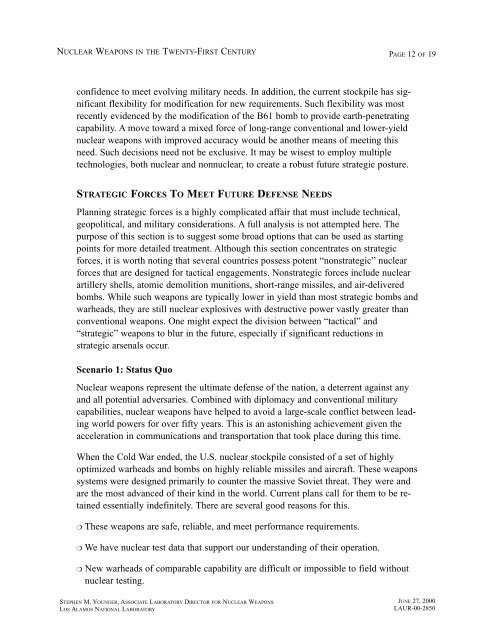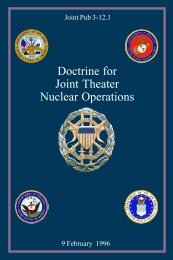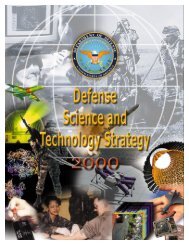Nuclear Weapons in the Twenty-First Century - Sciencemadness.org
Nuclear Weapons in the Twenty-First Century - Sciencemadness.org
Nuclear Weapons in the Twenty-First Century - Sciencemadness.org
Create successful ePaper yourself
Turn your PDF publications into a flip-book with our unique Google optimized e-Paper software.
NUCLEAR WEAPONS IN THE TWENTY-FIRST CENTURY<br />
PAGE 12 OF 19<br />
confidence to meet evolv<strong>in</strong>g military needs. In addition, <strong>the</strong> current stockpile has significant<br />
flexibility for modification for new requirements. Such flexibility was most<br />
recently evidenced by <strong>the</strong> modification of <strong>the</strong> B61 bomb to provide earth-penetrat<strong>in</strong>g<br />
capability. A move toward a mixed force of long-range conventional and lower-yield<br />
nuclear weapons with improved accuracy would be ano<strong>the</strong>r means of meet<strong>in</strong>g this<br />
need. Such decisions need not be exclusive. It may be wisest to employ multiple<br />
technologies, both nuclear and nonnuclear, to create a robust future strategic posture.<br />
STRATEGIC FORCES TO MEET FUTURE DEFENSE NEEDS<br />
Plann<strong>in</strong>g strategic forces is a highly complicated affair that must <strong>in</strong>clude technical,<br />
geopolitical, and military considerations. A full analysis is not attempted here. The<br />
purpose of this section is to suggest some broad options that can be used as start<strong>in</strong>g<br />
po<strong>in</strong>ts for more detailed treatment. Although this section concentrates on strategic<br />
forces, it is worth not<strong>in</strong>g that several countries possess potent “nonstrategic” nuclear<br />
forces that are designed for tactical engagements. Nonstrategic forces <strong>in</strong>clude nuclear<br />
artillery shells, atomic demolition munitions, short-range missiles, and air-delivered<br />
bombs. While such weapons are typically lower <strong>in</strong> yield than most strategic bombs and<br />
warheads, <strong>the</strong>y are still nuclear explosives with destructive power vastly greater than<br />
conventional weapons. One might expect <strong>the</strong> division between “tactical” and<br />
“strategic” weapons to blur <strong>in</strong> <strong>the</strong> future, especially if significant reductions <strong>in</strong><br />
strategic arsenals occur.<br />
Scenario 1: Status Quo<br />
<strong>Nuclear</strong> weapons represent <strong>the</strong> ultimate defense of <strong>the</strong> nation, a deterrent aga<strong>in</strong>st any<br />
and all potential adversaries. Comb<strong>in</strong>ed with diplomacy and conventional military<br />
capabilities, nuclear weapons have helped to avoid a large-scale conflict between lead<strong>in</strong>g<br />
world powers for over fifty years. This is an astonish<strong>in</strong>g achievement given <strong>the</strong><br />
acceleration <strong>in</strong> communications and transportation that took place dur<strong>in</strong>g this time.<br />
When <strong>the</strong> Cold War ended, <strong>the</strong> U.S. nuclear stockpile consisted of a set of highly<br />
optimized warheads and bombs on highly reliable missiles and aircraft. These weapons<br />
systems were designed primarily to counter <strong>the</strong> massive Soviet threat. They were and<br />
are <strong>the</strong> most advanced of <strong>the</strong>ir k<strong>in</strong>d <strong>in</strong> <strong>the</strong> world. Current plans call for <strong>the</strong>m to be reta<strong>in</strong>ed<br />
essentially <strong>in</strong>def<strong>in</strong>itely. There are several good reasons for this.<br />
❍ These weapons are safe, reliable, and meet performance requirements.<br />
❍ We have nuclear test data that support our understand<strong>in</strong>g of <strong>the</strong>ir operation.<br />
❍ New warheads of comparable capability are difficult or impossible to field without<br />
nuclear test<strong>in</strong>g.<br />
STEPHEN M. YOUNGER, ASSOCIATE LABORATORY DIRECTOR FOR NUCLEAR WEAPONS<br />
LOS ALAMOS NATIONAL LABORATORY<br />
JUNE 27, 2000<br />
LAUR-00-2850






